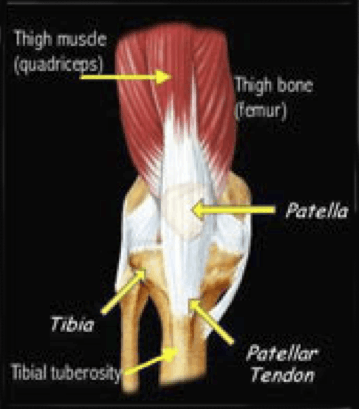
Wise Words
"Don't count time, make time count."

What is Osgood Schlatter's Disease?
Osgood Schlatter's (OS) disease is also known as tibial tuberosity apophysitis. It pulls the patellar tendon on the bony prominence of the upper shinbone (tibial tuberosity), just below the kneecap. OS most commonly occurs in boys age 13 and 14 and girls age 11 and 12. Osgood Schlatter's is more common during "growth spurts" and in children who play sports requiring running or jumping.
What causes Osgood Schlatter's Disease?
Osgood Schlatter's overuse syndrome causes pain, swelling, and tenderness over the tibial tuberosity. OS is common during your child's adolescent growth spurt when new bone forms a cartilage growth plate at either end of the bone. Cartilage isn't as strong as bone, and stress on the growth plate can cause it to become swollen and painful. During activities that place stress on the leg, the pull of the quadriceps (thigh) muscle can put tension on the band of tissue that connects the knee to the tibia (patellar tendon). The patellar tendon can pull away from the raised area on the tibia where it attaches, resulting in pain and swelling. With repeated trauma, new bone grows back during the healing, which causes a bony lump often felt just below the knee.
Signs and Symptoms
Pain, swelling, and tenderness at the tibial tuberosity that worsens with activity (running and jumping) and improves with rest, pain when contracting quadriceps muscle against resistance or when contracting the muscles with the leg straight. Even after symptoms have resolved, a "bump" on the tibia in the area of the swelling may remain. This bump may persist to some degree throughout your child's life but will not interfere with knee function.
Treatment Options
Rest: Osgood Schlatter's requires proper rest if it is to heal properly. Decrease exercise frequency and intensity; avoid impact activities (running and jumping) and other painful activities. RICE (rest, ice, compression, elevation) to aid in managing inflammation and soreness. General treatment guidelines include:
- Increasing the flexibility of the lower extremity muscles (primarily quadriceps and hamstrings)
- Strengthening exercises
- Taping techniques
- Options of knee bracing to reduce the tension on the knee
Osgood Schlatter's disease usually goes away with time. The pain generally lasts weeks to months and can reoccur until your child stops growing. The pain and swelling should disappear when your child stops growing because the patellar tendons become much stronger. Only rarely does Osgood Schlatter's disease persist beyond the growing stage.
Your physical therapist will give you specific guidelines for your child's individual needs.
